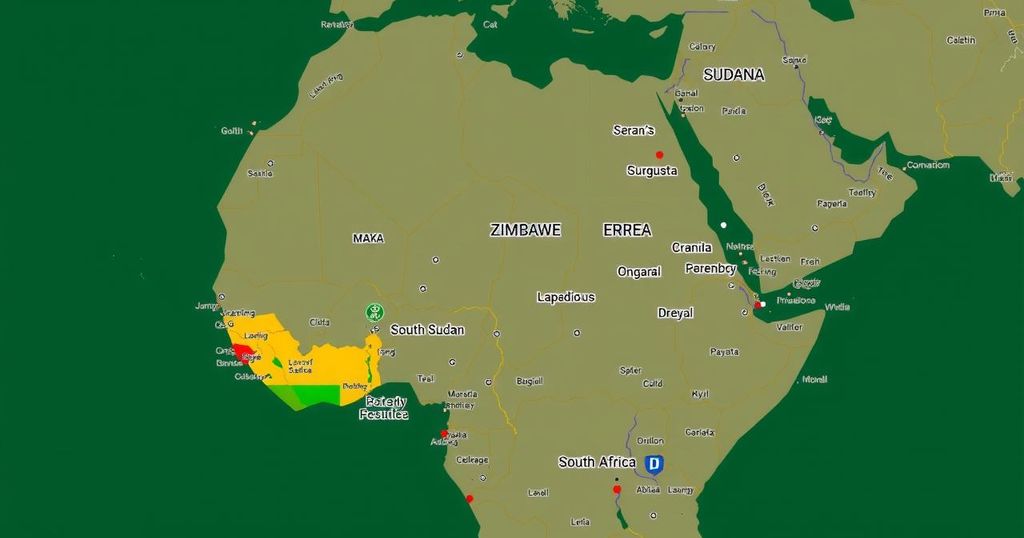This article explores the interconnectedness of public debt and access to education in Zimbabwe, Eritrea, South Sudan, and South Africa. It highlights how financial pressures and governance issues impede educational investments, leading to inadequate infrastructure and learning outcomes. The analysis underscores the necessity for effective debt management while adhering to international frameworks that prioritize education as a fundamental human right. The article concludes with a call for comprehensive reforms and collaborative efforts to ensure that educational needs are addressed amidst financial challenges.
The intricate relationship between public debt and educational access has become increasingly evident in several nations, notably Zimbabwe, Eritrea, South Sudan, and South Africa. The challenges posed by debt—ranging from underfunded schools to systemic corruption—highlight the dire consequences on educational infrastructures and learning outcomes. By examining these countries, we uncover critical lessons about the necessity of effective debt management to uphold the right to education, emphasizing the importance of prioritizing fiscal policies that address educational investments regardless of financial pressures.
Zimbabwe’s public education system suffers gravely from the historical context of hyperinflation and economic mismanagement, which has led to inadequate funding and overstrained resources. Compounding this issue is the country’s substantial debt burden, which diverts necessary funds from educational services, resulting in insufficient infrastructure and limited training opportunities for educators. The implications of this cycle extend beyond immediate educational prospects, inhibiting Zimbabwe’s long-term national growth and the fulfillment of citizens’ rights.
In Eritrea, extreme self-reliance and isolationist policies have tightly constrained resource allocations, particularly in education. His nation prioritizes military spending over vital services like education, hampering the quality of educational opportunities. Furthermore, the requirement of national service disrupts young people’s educational pathways, significantly affecting their access to quality schooling. Eritrea’s financial limitations are exacerbated by a lack of international support, signaling an urgent need to reevaluate fiscal priorities.
South Africa’s economic status does not exempt it from the challenges of balancing debt management and educational investment. The legacies of apartheid have created stark educational disparities across regions and socio-economic groups, compounding issues of inequality. Despite notable strides in educational access, persistent financial strains and corruption within institutions hinder effective resource allocation, reflecting broader economic challenges within the nation.
In South Sudan, ongoing conflict and corruption have resulted in substantial educational deficits, with national budget allocation severely favoring debt repayment over critical educational investments. Although the country possesses significant oil revenues, mismanagement has led to woefully inadequate educational infrastructure. The dire conditions have compromised the right to education for many, as a considerable portion of the population faces displacement and temporary schooling arrangements. This inequity is rooted in a national budget seemingly at odds with the educational needs of its citizens.
Through these examples, we discern an urgent lesson: the intersection of debt and education requires comprehensive reforms and collaborative endeavors between nations and lenders alike. The sustainability of debt burdens profoundly influences each nation’s capacity to invest in educational futures, thereby necessitating effective debt management that prioritizes educational adequacy and quality.
This understanding expands into broader global contexts, underscoring the importance of adhering to international law frameworks such as the ICESCR and the United Nations Sustainable Development Goals. The ICESCR mandates states to secure availability, accessibility, acceptability, and adaptability in education. Countries entangled in debt burdens must engage with lenders to safeguard education budgets from disproportionate cuts during economic hardships, thus upholding the right to education. Likewise, the SDGs demand a balanced fiscal policy approach that acknowledges the impact of debt on essential public services, especially education, through international support and relief initiatives.
Effective debt management strategies also necessitate transparency and anti-corruption measures to ensure educational resources are utilized efficiently. Engaging communities and stakeholders in the budgeting process fosters accountability and places educational needs at the forefront. Local organizations and citizens must advocate for equitable resource allocation to influence debt management’s education-related outcomes positively.
In conclusion, the debt-education dynamic reveals critical complexities surrounding governance and economic constraints affecting educational access. The experiences of Zimbabwe, Eritrea, South Sudan, and South Africa collectively emphasize the importance of adopting a holistic approach to fiscal policies and prioritizing educational investment amidst debt challenges. Addressing these issues collaboratively through robust fiscal reforms and anti-corruption strategies will enrich educational opportunities and promote equitable futures for all citizens.
This article examines the profound relationship between public debt and the right to education, highlighting the experiences of Zimbabwe, Eritrea, South Sudan, and South Africa. By focusing on how financial constraints and governance challenges intersect with educational access, the analysis underscores the necessity for effective debt management to enhance educational outcomes. The discussion draws upon international frameworks advocating for education as a human right and considers how various nations can address debt-related barriers to achieving quality education for all. The context of this examination is rooted in historical and socio-political factors contributing to the current educational challenges faced by these countries. Each nation’s unique circumstances, including economic mismanagement, corruption, and the prioritization of military spending over education, reveal the critical need for reformed fiscal strategies that align with international commitments to uphold the right to education.
The intersection of debt and education highlights a complex interplay of economic constraints and governance challenges that significantly affect educational access. The case studies of Zimbabwe, Eritrea, South Sudan, and South Africa demonstrate the imperative need for thoughtful and inclusive debt management approaches aimed at enhancing educational investments. By prioritizing education in fiscal policies, addressing corruption, and engaging communities, nations can work towards overcoming barriers that have historically hindered educational opportunities. The insights derived from this exploration call for concerted efforts among policymakers, international stakeholders, and civil society to ensure that debt alleviation measures support rather than undermine the fundamental right to education, fostering sustainable development and social equity.
Original Source: www.amnesty.org






